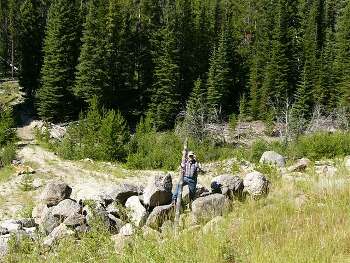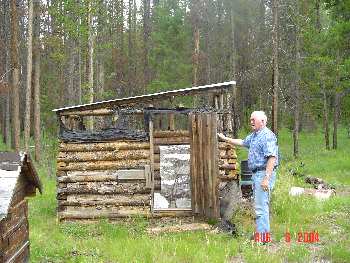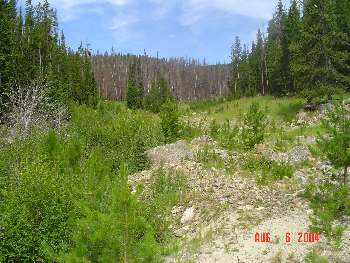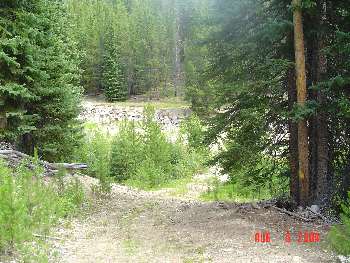
| 10 Idaho Claims (L410) |
| located in the Mackinaw Mining District |
|
SOLD
|
| 10 unpatented contiguous mining claims |
| ranging from 20 - 80 acres |
| 460 acres total |
| x |
| Claims range in price from $2,750 - $15,500 each |
| Buy One, Two, or All of the Claims |
| x |
| Buy all 10 claims for $61,700 |
|
xSOLD
|
|
Will
Negotiate
|
LOCATION:
These are 10 unpatented, contiguous gold mining claims totaling 460 acres. They are located in the Salmon-Challis National Forest, State of Idaho, Lemhi County, Mackinaw Mining District. This is very near the Frank Church/ River of No Return Wilderness, which at 2.3 million acres is the largest wilderness in the lower 48 states. The claims are located about 40 miles from Salmon, ID via forest service roads. The roads are graveled and passable by 2-wheel drive except for the last mile, which requires 4-wheel drive.
On the way to the claims, the road passes the Bear track Mine at Leesburg. The Bear track is a 3,795 acre claim located near the original discovery made my F. B. Sharkey in 1866 which led to a gold rush to central Idaho. The claim in is the final stages of gold recovery, reclamation and closure. The mine produced over $100 million worth of gold.
HISTORY & MYSTERY
These claims are remote and that's good. Many parts are good, virgin watershed. Though they were first claimed in 1927, only about 2,000 feet of 12,000 feet of Jureano Creek have been worked. The other two watersheds are virtually untouched.
These were originally claimed by the brothers Art and Frank Butschke. Frank was an engineer, educated at MIT. They built log cabins and support buildings and lived there from 1927 to 1954. During that time, they focused their attention on the Jureano Creek. They dammed Jureano and two other drainages. The impounded water was used both in the gold mining operation and to turn a hydroelectric generator at Frank's cabin. Evidence of their operation remains today; the piles of boulders they moved using horses and rigging. The remains of Frank's cabin and out buildings still stand, though Art's cabin burned in a forest fire in 2000.
Treasure hunters have damaged the old buildings in pursuit of the fabled riches that Art is said to have hidden somewhere on the claim. As the story goes, Frank passed away. His heirs did not share his passion for wilderness living and so Art worked the claims alone until he was too old to continue. He went to a rest home in Mt. St. Helen's Oregon where apparently he had an acquaintance. He asked if they would provide him care for the balance of his life. They said they would and asked him how he would pay. Art went to his car and returned with two quart jars of gold and asked, "will this take care of it?" He was assured that the gold was certainly enough. After some time, Art lay dying and summoned his nurse with whom he had become good friends. He called her close to him and whispered his final words, "I left lots of gold in Jureano". It is not known if Art meant he had hidden his gold or he felt he had not mined all the gold that was there to be found; hence the mystery.
Thereafter the claims were sold to Rhoda Fry, then to two half-sisters that lived in Art's cabin until 1980 when they sold the claims to Don Adams. At 75 years old, Don decided he needed to retire and he sold the mines to my wife and me.
During the 24 years that Don owned the claims, he entered into a 10 year lease with American Gold Mining Company for $10,000 year and then in 1992 he attempted a large scale mining operation with a group of Canadian investors.
American Gold Mining had aggregated a total of 26,000 mining claims. When the Bureau of Land Management made a special annual assessment of $100 per claim, they liquidated their holdings. Though they paid $100,000 cash over the term of the lease, they never mined the property.
In 1992 Don Adams partnered with a group of Canadian investors to mine the claims. The investors infused $500,000. A mining camp was built complete with a 60- foot cook trailer, tent-housing, septic and water. Portions of the Butschke canals and the dam on Jureano Creek were used to bring water to the excavation site. Settling ponds were built. A large bulldozer, loader, grizzly and associated equipment were brought on site. On the first day of operation, the site superintendent left, never to return. He had embezzled the remaining capital. Eventually he was sent to prison for embezzlement, where he died. The project ended and the site was restored using the money posted in the bond. Some remnants of the project can still be seen.
THE LAW
This is a large topic and I encourage you to call the owner with any questions that are not answered in this brief discussion.
When you purchase an unpatented mining claim, you own all of the rights to all minerals on the claim. Your ownership is an interest in real property. You can leave it to you heirs, borrow against it, and even live on it with certain restrictions. Your ownership is perpetual, so long as you meet the annual requirements.
There are 3 basic requirements:
- Each year, before December 31 you must file an "Affidavit of Annual Representation". This is a description of the work performed on your claim. You must perform $100 worth of work annually. You must file the Affidavit with Lemhi County (fee $9.50) and then with the BLM (fee $5/ per claim).
- Each year you must file the "Small Miner's Waiver" before July 5 in order to keep your annual assessment fee at $5. This is filed with the BLM and there is no fee.
- You must file a plan of operation with the U.S. Forest Service before you begin working your claim. If your plan changes, you would need to refile to reflect the changes.
To receive more information,
email us and ask about the
10 Idaho Claims L410
fax (208) 265 5377
| home main site | home mobile |



